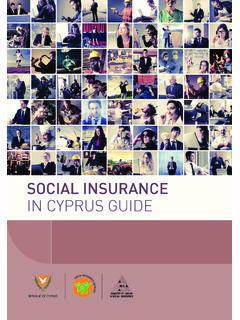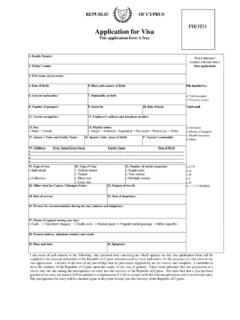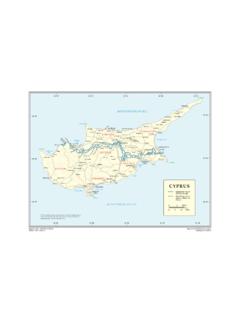Transcription of Analysis of the Function and Structure of the …
1 Document of The World Bank FOR OFFICIAL USE ONLY. Analysis of the Function and Structure of the Ministry of Education and Culture of the Republic of cyprus April 4, 2014. Poverty Reduction and Economic Management Unit Southern Europe Program Europe & Central Asian Region This document has a restricted distribution and may be used by recipients only in the performance of their official duties. Its contents may not otherwise be disclosed without World Bank authorization. Contents Contents .. 1. Executive Summary .. 4. Section 1. Context .. 9. Section 2. The History of Reform .. 10. Context .. 10. Previous Recommendations and Reform 11. Conclusions .. 15. Section 3. Policy and Policy Development .. 16. Section 4. Analysis of the Education Sector .. 17. The Structure of the 17. The Performance of the Sector .. 19. Comparison with EU Countries: Governance, Monitoring, and Structure .. 23. Section 5. Functional Analysis and Policy Options .. 28. Section 6. Functional Analysis of State-owned Enterprises and Policy Options.
2 44. 1. References .46. Annex .. 48. Annex 1a: Current Structure of 49. Annex 1b: Proposed Structure of 50. Annex 2: Analysis of current and proposed MoEC 52. Annex 3: Proposal for the Department of Policy and Strategic Planning and Department of General Education .. 67. Annex 4: Subnational Structure .. 73. Annex 5 Action Plan .. 76. Annex 6: Analysis of the State-Owned Enterprises cyprus Sports Organization and cyprus Youth Board .. 82. Annex 7: Unit functions, Staffing profiles and indicative numbers for key departments .. 94. Annex 8: 104. Annex 9: Reform Indicators .. 106. List of Figures Figure 1: Expenditure on Public and Private Educational Institutions Per Pupil, 2010 .. 20. Figure 2: TIMSS Scores for 8th Grade 21. Figure 3: PISA Scores and Public Expenditures (as % of GDP) .. 21. Figure 4: Comparative Pupil-Teacher Ratios, ISCED 1-3, 2011 .. 23. Figure 5: Teachers and Students in Primary and Secondary Education .. 23. Figure 6: Composition of the Staff in the Ministry of Education and Culture.
3 26. 1. List of Boxes Box 1: School Autonomy in Europe 24. Box 2: Supervision and Support services for Primary and Secondary Education in Other Countries: How Countries Assess School Performance . 25. 2. Acronym Meaning CERE Center for Educational Research and Evaluation CoM Council of Ministers CPD Continuing Professional Development CPI cyprus Pedagogical Institute CSA Committee of Seven Academics CSO cyprus Sports Organization DAOs District Administration Offices DEOs District Education Offices DRR Disaster Risk Reduction ECE Early Childhood Education EIAO European and International Affairs Office EMIS Education Management Information System EPS Education Psychological Services ERO Education Review Office ESC Educational Service Commission ESF European Social Fund EU European Union GDP Gross Domestic Product GED General Education Department HED Higher Education Department HQ Headquarters HRMIS Human Resources Management Information System ICT Information and Communication Technologies IIEP International Institute for Educational Planning ILO International Labour Organization ISCED International Standard Classification for Education KEDI Korean Educational Development
4 Institute KYSATS cyprus Council for the Recognition of Higher Education Qualifications LLL Lifelong Learning MCW Ministry of Communications and Works MoEC Ministry of Education and Culture MTEF Medium-term Expenditure Framework NVQF National Vocational Qualifications Framework OECD Organization for Economic Cooperation and Development OELMEK Union of Secondary General Education OFSTED Office for Standards in Education OLTEK Union of Secondary Technical and Vocational Education PISA Program of International Student Assessment POED Union of Pre-primary and Primary Education PSPD Policy and Strategic Planning Department SEKAP Council for Education and Accreditation SGC School Governing Council TIMSS Trends in International Mathematics and Science Study TVE Technical and Vocational Education TVET Technical and Vocational Education and Training UK United Kingdom UNESCO United Nations Educational Scientific and Culture Organization YB Youth Board of cyprus 3. Executive Summary Context 1.
5 The Government of cyprus is committed to providing a quality education to all children. The government manifesto sets out a vision of an educational system which encourages a nation of free- thinking people within a democratic framework, an investment in education that is inclusive, allows for the individual to develop and express themselves, and provides opportunity for learning throughout life.. 2. The Function of the Ministry of Education and Culture (MoEC) is to develop and implement education policy in line with the government's declared vision. To this end, the MoEC is required to develop strategic goals and the programs to fulfill the government s vision, to prepare annual operational plans, to monitor and assess progress towards achieving the goals, and to support schools in implementing the programs. In addition, the MoEC is responsible for research related to education and culture, for the continuing professional development for teachers and school principals, and for the inspection of schools.
6 History of the Reforms 3. There have been several attempts to reform the education sector in cyprus . Several experts have assessed the main challenges faced by the education sector in cyprus , and several studies containing reform proposals have been put forward since the late 1990s. Following cyprus s accession to the EU, the government launched a reform effort, but little has resulted from that. While experts have made substantial suggestions on how to reform the institutional organization of the education sector, teacher policies, evaluation and assessment mechanisms, the higher education subsector, and the curricula, only the curriculum reform has been carried out. 4. The country's investment in education does not yield commensurate outcomes. Public expenditure on education in cyprus is around percent of GDP, which is high by international and European standards. Annual public and private expenditure in cyprus is 9,145 per pupil, which is higher than the EU average of 6,900. Although it is difficult to draw any concrete conclusions because of a lack of learning achievement data, it does appear that the high expenditures on education are not translating into improved learning outcomes for children.
7 5. cyprus 's educational outcomes, as measured by average national scores in PISA and TIMSS, are below what might be expected given the country's level of economic development and investments in education. Results from PISA and TIMSS place students in cyprus significantly below the OECD average in reading, mathematics, and science. There is very little formal assessment of student learning. Consequently, it is difficult for the MoEC to identify and address systemic issues of education quality and to adjust policy in a timely manner. 6. The hiring of teachers does not take account of demographic trends. Despite the drop in the school age population, the number of teachers employed in the system has grown steadily over the last few years. In addition, policies related to teacher selection, promotion, and evaluation are not conducive to providing effective education Management of the Education Sector 7. The management of education is highly centralized with a large central ministry of 717 staff managing a sector with 12,065 teachers (a ratio of 1 to 17) and 144,000 students (a ratio of 1 to 201).
8 These ratios are very high compared to other countries in Europe and may reflect inefficiencies in the 1. These issues are analyzed in detail in the accompanying report on Teacher Policies in cyprus .. 4. system. The Ministry of Education and Culture (MoEC) has 14 departments (some of which also include several units) all of which report directly to the Permanent Secretary who is also the accounting officer. This places a considerable administrative burden on the Permanent Secretary s office, thus limiting the time it has available for policy implementation, strategic planning, program development, and assessment. A number of departments appear to have a large number of staff for the relatively few functions that these departments have been assigned compared to their equivalents in comparable countries. The Ministry of Education and Culture 8. The Analysis in this report of Cyrus's education performance and of the functions and of the Structure of the MoEC suggests that the allocation of responsibilities is not always clear and that the Structure of the MoEC is not optimal for delivering its mandate.
9 This section summarizes the report s assessment of the management Structure and the related functions of the MoEC and presents some recommendations for reform. a) Ministry leadership: The ministry s core strategic functions for policy and strategic leadership are compromised by an unduly heavy burden of administrative and bureaucratic work. For example, the Permanent Secretary has at least 14 departments reporting directly to her, with little or no delegation of decision-making. The offices of the Minister and the Permanent Secretary are staffed by seconded teachers rather than by contract staff or civil servants who have the relevant public service and sectoral backgrounds. Recommendation: We suggest that the existing departments be reorganized into fewer and larger departments while delegating many managerial responsibilities from the Minister and the Permanent Secretary to the departments, which would free up the leadership to focus on strategic issues. To this end, the office of the Minister could be staffed by contracted external experts while that of the Permanent Secretary could be staffed by appropriately qualified civil servants.
10 B) Policy development and implementation leadership: The functions of strategic planning, goal setting, and programming development (including medium-term results-based budgeting) are not clearly articulated in any document. Nor is there is any institutional home for rigorous data collection or Analysis to aid senior policymakers. Consequently, there is no evidence available to inform policymaking and adjustments. Planning is fragmented across all of the many departments within the MoEC and tends to take only a short-term perspective, and there is no rigorous assessment or quality assurance process. Recommendation: We recommend that a Department for Policy and Strategic Planning be established with responsibility for: i) Policy and strategic planning ii) Public finance management iii) The education management information system and all data collection iv) Quality assurance and performance assessment v) The management of European and international affairs. c) General education leadership: Currently the primary, secondary, and technical and vocational education departments of the MoEC undertake some short-term planning and make some decisions on a range of school-level administrative matters.








